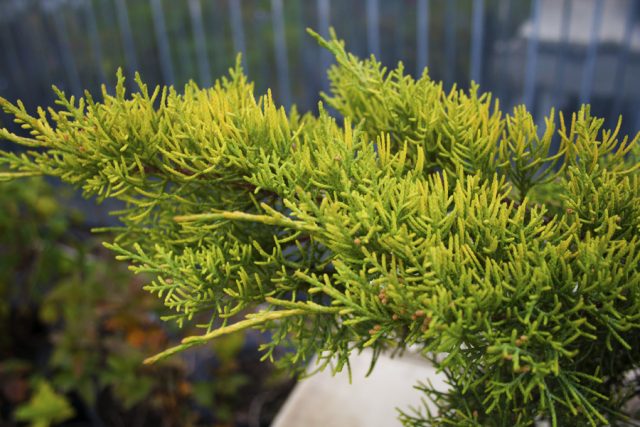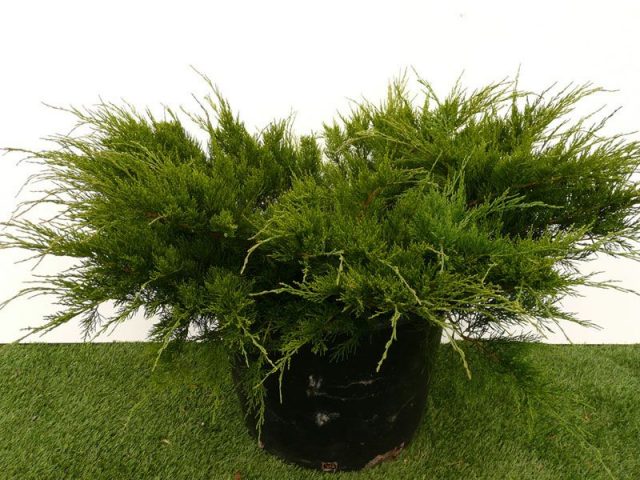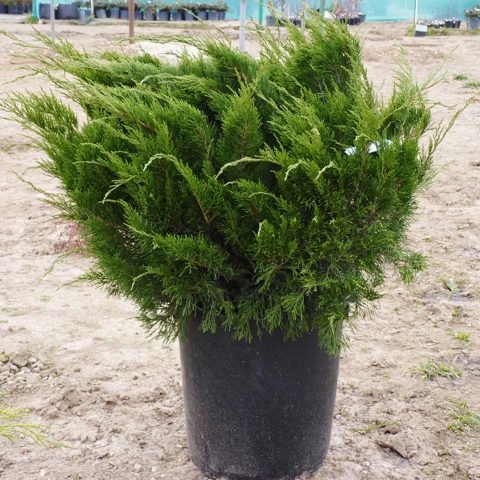Content
- 1 Description of the average juniper
- 2 Juniper pfitzeriana in landscape design
- 3 Medium juniper varieties
- 3.1 Juniper medium pfitzeriana Aurea
- 3.2 Juniper medium King of Spring
- 3.3 Juniper medium pfitzeriana Glauck
- 3.4 Juniper pfitzeriana compacta
- 3.5 Juniper medium Blue and Gold
- 3.6 Juniper medium Gold Coast
- 3.7 Juniper medium Mordigan Gold
- 3.8 Juniper medium Dubs Frosted
- 3.9 Juniper medium Methot
- 3.10 Juniper pfitzeriana Carbury Gold
- 3.11 Juniper pfitzeriana Wilhelm Pfitzer
- 3.12 Juniper medium Blonde
- 3.13 Juniper medium Saybrook Gold
- 3.14 Juniper Medium Mint Julep
- 3.15 Juniper medium Gold Kissen
- 3.16 Juniper medium Old Gold
- 3.17 Juniper medium Gold Star
- 4 Planting and caring for juniper pfitzeriana
- 5 Propagation of juniper pfitzer
- 6 Pests and diseases of juniper pfitzeriana
- 7 Conclusion
Medium juniper is an ornamental coniferous shrub, bred by crossing Cossack and Chinese junipers. The plant is very popular in gardening because its varieties have very interesting shapes and colors, and caring for the plant is quite simple.
Description of the average juniper
Medium juniper, or, as it is also called, pfitzeriana, is a fairly young variety, artificially bred in Germany at the end of the 19th century. The shrub received its name in honor of one of the nursery employees who took part in the selection - Wilhelm Fitzer.
According to its characteristics, the average pfitzerian shrub has features of both the Cossack and Chinese varieties. Juniper pfitzeriana differs from horizontal varieties in that it can rise above the ground up to 3 m, and the crown diameter of the average juniper reaches 5 m. However, it remains much lower than vertical junipers and, thus, occupies an average position in height.
The branches of the average juniper usually rise vertically upward, but at the ends they bend in an arc towards the ground. The needles of the shrub are soft and not prickly, on old branches and closer to the trunk they are needle-shaped, and at the ends of the shoots they have scales. Most varieties of medium juniper are bright green or yellowish in color, although medium blue juniper is also found.
From a growing point of view, pfitzeriana is a very convenient garden variety. The average shrub tolerates conditions of lack of moisture and frost well, and is undemanding to soil and ecology. Planting a medium-sized juniper in a summer cottage allows you not only to decorate the garden, but also to improve the health of the air - the phytoncides released by the plant eliminate pathogenic bacteria and fill the garden with a pleasant aroma.
Juniper pfitzeriana in landscape design
Gardeners and designers value the medium juniper primarily for its versatility in garden landscaping.
- The low pfitzeriana plant can be used in the design of small compact compositions; the medium juniper goes well with flower beds and flower beds, alpine slides, and rose gardens.
- Pfitzeriana is used in the design of coastlines; medium-height shrubs are used to create borders; it can also be used to create low hedges that divide the garden into parts.
- Medium juniper looks good next to groups of taller trees. If you correctly select the shapes and shades of the plant crown, then the Pfitzerian coniferous shrub will help emphasize the grace and beauty of neighboring plantings.
- Due to the fact that most varieties of medium juniper spread widely in diameter, they are used to decorate rocky and desert areas of space, forming a “green cushion” raised above the ground.
Medium juniper varieties
In the time that has passed since the appearance of juniper pfitzeriana, dozens of different varieties of medium-sized shrubs have been bred. Some of them are especially in demand among landscape designers and ordinary summer residents because they have attractive shapes and do not require careful maintenance.
Juniper medium pfitzeriana Aurea
The variety is characterized by strong growth in width - an adult medium juniper Pfitzeriana Aurea can reach 5 m in diameter. Pfitzeriana has a spreading crown and bright yellow-green needles with a golden tint.It grows slowly and is often used to create a lower layer of vegetation in park areas. But it is not suitable for small flower beds, because as it grows it will simply crowd out other plants.
It is unpretentious to growing conditions and tolerates poor soils and drought. But at the same time, Pfitzeriana Aurea requires an abundance of sunlight - in the shade, the average shrub grows much worse and is susceptible to diseases.
Juniper medium King of Spring
Pfitzeriana is distinguished by non-standard dimensions for the average juniper; as a rule, the bush does not exceed 50 cm in height. At the same time, the plant can spread up to 2 m in diameter, which allows it to be actively used for decorating lawns and living carpets on uneven terrain.
The needles of this variety of juniper pfitzeriana are bright, green-yellow, but the plant retains this shade only in illuminated areas, and in the shade it darkens and loses its unusual appearance.
Juniper medium pfitzeriana Glauck
Juniper Pfitzerianaglauca is capable of spreading branches up to 4 m wide, but reaches no more than 2 m in height. The crown is irregularly rounded and dense, the color of the needles is bluish-blue in the sun or greenish-gray in the shade.
Pfitzeriana Glauka prefers well-lit areas, but also tolerates light shade. It tolerates drought and frost well; it prefers soil that is loose and well saturated with oxygen. In landscape design, Glauka looks especially good in combination with herbaceous plants and as part of alpine slides.
Juniper pfitzeriana compacta
A short, slow-growing variety, it can reach only 1.5 m in height and grows to approximately 2 m in diameter.A young medium-sized pfitzerian shrub has rigid horizontal shoots; subsequently, the branches rise slightly upward. The color of the needles of the medium juniper variety Pfitzeriana Compacta is green with a grayish tint, the needles are scaly at the ends of the branches and needle-like closer to the trunk.
Compacta is one of the few medium-sized junipers that tolerate shaded conditions well. Pfitzeriana is characterized by increased endurance and tolerance to almost any conditions, therefore it is especially often used in urban gardens and summer cottages with poor soils.
Juniper medium Blue and Gold
As you can see in the photo of Blue and Gold juniper, an unusual feature of this variety is the two-color color of the bushes, some shoots of which are yellow and others are greenish-blue. This is the reason for the name of the middle juniper Blue and Gold. The shrub can reach a height of 1.5 m, and a width of 2 m, and it grows very slowly, several centimeters per year.
It is necessary to grow Blue and Gold in the same way as most other varieties, paying special attention to sunlight and loose soil.
Juniper medium Gold Coast
Pfitzeriana is characterized, first of all, by the bright and cheerful color of the crown - the needles are green-yellow with a golden tint. The average Gold Coast juniper usually reaches no more than 1.5 m in height, and can grow up to 3 m in width, spreading shoots to the sides that bend towards the ground.
Typically, Gold Coast Pfitzeriana is planted singly or in small groups to highlight its beautiful shape and color. It is necessary to take into account that the plant can boast of an unusual color only in illuminated areas.
Juniper medium Mordigan Gold
The variety belongs to the category of low-growing pfitzerian bushes - an adult plant does not rise above 1 m, although it can spread shoots 2 m wide. The branches of the average shrub are located horizontally and bend towards the ground, and the very soft needles of the Mordigan Gold juniper pfitzeriana have a pleasant golden-yellow hue.
The average Mordigan Gold juniper adapts well to almost any conditions and grows well in poor soils and in regions with cold winters. But when planting a plant, it is necessary to ensure good illumination of the selected area and select light soils.
Juniper medium Dubs Frosted
The short-growing variety Dubs Frosted reaches just a meter in height when mature and about 3.5m in width. The crown of Pfitzeriana is spreading and dense, the ends of the shoots slightly descend to the ground. Mature needles are light green in color, while new shoots are bright gold in color.
Dubs Frosted has very few requirements for growing conditions. However, the variety must be planted in sunny places, otherwise its original color will fade greatly.
Juniper medium Methot
Medium juniper Pfitzeriana Methot belongs to the group of tall varieties - in adulthood it can reach about 3 m in height and 4-5 m in diameter. The needles on the spreading crown are scaly, soft to the touch with a yellow-green tint. Fresh shoots of the bush have a golden color. The branches of Methot are usually horizontal and slightly raised upward, but drooping at the ends.
Methot exhibits great tolerance to growing conditions and is ideal for planting in poor soils.You just need to make sure that the shrub has enough light; in conditions of constant shading, it will lose its attractive color.
Juniper pfitzeriana Carbury Gold
The spectacular low-growing variety Carbury Gold was awarded an award by the English Royal Horticultural Society for its beauty and pleasant golden color of the crown. The height of an adult shrub rarely exceeds 1 m; the diameter of the pfitzerian can reach 2.5 m. The shoots of the shrub are directed slightly upward, but are located horizontally and bend towards the ground at the ends.
Like most juniper varieties, Carbury Gold tolerates fairly harsh growing conditions. But the shrub remains demanding in terms of the amount of sunlight; in the shade its needles fade and become less beautiful.
Juniper pfitzeriana Wilhelm Pfitzer
This variety, named directly after one of the breeders of the medium shrub, has a bright green color of needles and a spreading crown. Juniper average Wilhelm Pfitzer belongs to the category of tall shrubs and in adulthood can reach 3 m in height and 5 m in width. True, it grows quite slowly, no more than 10 cm per year even in ideal conditions.
Juniper medium Blonde
The variety called Blond is characterized by rather short growth - the size of the average juniper does not exceed 1.2 m in height and about 2 m in diameter. The shoots of the shrub are thick and spreading, sloping down; the needles in a well-lit area acquire a golden hue.
Pfitzeriana Blonde tolerates drought and winter frosts well, but is sensitive to soil density.The soil at its roots should be loose and well-drained, since stagnant moisture also poses a danger to the plant.
Juniper medium Saybrook Gold
The Saybrook Gold variety grows to approximately 1.5 m when mature and can spread shoots up to 3 m wide. At the beginning of the life cycle, the branches of the plant are creeping, then they become raised, but at the ends they still bend down. The color of the needles on a medium-height plant is green with golden tips on young shoots.
The variety tolerates drought and winter cold well. Saybrook Gold prefers illuminated areas and grows as beautiful as possible under the sun's rays, but it also feels good in light shade.
Juniper Medium Mint Julep
The variety, especially popular when creating hedges, has a dense crown and strongly curved arched shoots. It can reach a maximum height of 1.5 m; the color of the needles on an adult medium-sized plant is bright green.
Juniper medium Gold Kissen
The Gold Kissen variety, which is also called the “golden pillow,” reaches up to 1 m in height and about 2.5 m in diameter, and can add 15 cm per year. The crown of a medium-sized shrub is spreading, asymmetrical, the needles have a golden hue on fresh shoots and are brightly colored. -green on old branches.
Juniper medium Old Gold
A low variety, capable of reaching up to 1.5 m in height and only about 1 m in width. It has a compact crown of regular geometric shape, the adult needles of the average juniper of this variety are green-golden, and the needles on young shoots are yellow.
Juniper medium Gold Star
A slow-growing variety, reaching up to 1.5 m in height and width, has a spreading horizontal crown.In sunny areas, the needles of the average juniper acquire a golden hue, and this is the decorative value of Gold Star.
Planting and caring for juniper pfitzeriana
The average juniper Juniperus Pfitzeriana is not very demanding in terms of growing conditions, not least for this reason why gardeners love it. But in order for the shrub to grow beautiful and healthy, you need to know the basic rules of caring for the plant.
Preparing seedlings and planting area
The site for growing medium juniper can be almost anything. There are only a couple of main requirements that need to be met:
- good illumination of the area - most medium-sized pfitzerian junipers begin to fade in the shade;
- loose and aerated soil - junipers do not tolerate dense soils well.
If the soil in the selected area does not meet the requirements, you can prepare it yourself - make a soil mixture consisting of peat, sand and coniferous soil. A hole for a seedling is dug within a month; it should be approximately 2.5 times larger in size than the roots of the seedling itself along with an old lump of earth.
Landing rules
Planting in the ground is carried out in the spring according to standard rules.
- Light soil or an artificial soil mixture is poured into the prepared, drained hole to the middle, and then the seedling is lowered into the hole along with a lump of earth at the roots.
- The hole is filled with soil to the very top, but there is no need to thoroughly compact the soil around the trunk.
- Immediately after planting, the shrub is properly watered and the soil is mulched with tree bark or sawdust.
Watering and fertilizing
It is very easy to care for the average juniper during the warm season. It needs additional watering only during the driest periods, and the rest of the time it is content with the natural amount of moisture.
As for fertilizing, it is done once a year - in April or early May you need to add nitrogen fertilizers to the soil. At the same time, it is categorically impossible to feed a medium-sized shrub with organic matter; for a coniferous plant, fertilizers of this type are destructive.
Mulching and loosening
It is recommended to mulch the soil at the roots of the average juniper once a year with peat, mown grass or pine needles. A layer of mulch will prevent weed and will not allow moisture to evaporate prematurely. Loosening the soil is necessary, but it must be done very carefully and carefully, since the roots of the plant are located close to the surface of the earth and may be damaged.
Trimming and shaping
Sanitary pruning for medium-sized junipers is mandatory. Removing dry, broken and diseased branches is necessary to maintain the health of the plant. As for decorative formation, it is performed as necessary on mature shrubs.
Preparing for winter
In the fall, shortly before the onset of cold weather, the ground around the roots of the average juniper must be covered with a dense layer of peat. Young low-growing shrubs are covered with spruce branches for the winter or a snow cushion is formed on a special protective frame. If juniper grows in a sunny area, then in winter a screen should be installed on the most illuminated side - the bright winter sun can cause burns to the plant.
Propagation of juniper pfitzer
Pfitzeriana, like other varieties, is successfully propagated using cuttings.
- As planting material, young spring shoots about 12 cm long are cut from the bush and cleared of needles from both ends.
- For a couple of months, the cuttings are placed in a mini-greenhouse - a small box with a substrate suitable for juniper.
- The top of such a box is covered with plastic film to create a suitable temperature and humidity, but the film needs to be opened briefly every day.
Rooting occurs in approximately 2 months. After this, the young seedlings, together with the existing substrate, are transplanted into larger boxes and grown indoors for another 1-2 years, after which they are planted in open ground.
Pests and diseases of juniper pfitzeriana
The generally hardy plant is susceptible to a number of fungal diseases. The greatest danger to shrubs is:
- brown shutte - manifested by yellowing and shedding of needles;
- drying out of branches - the shoots of the bush dry out and become distorted;
- rust - orange growths appear on the shoots and needles of the average juniper.
The fight against diseases is carried out, first of all, by pruning all affected parts of the plant. Then the bush is carefully treated with fungicides - copper sulfate, Bordeaux mixture, and specialized products.
Insects such as aphids, scale insects and mealybugs can also damage pfitzerian plants. Their appearance is easy to prevent; it is enough to treat the bushes with insecticidal agents, for example, Aktara or Aktellik, 1-3 times a season.
Conclusion
Medium juniper is a beautiful coniferous plant that does not require much effort from the gardener when growing. When caring for it, it is enough to follow the most basic rules so that the shrub will delight you with its beautiful shapes and bright colors of needles.




























